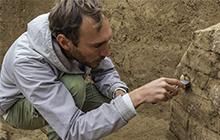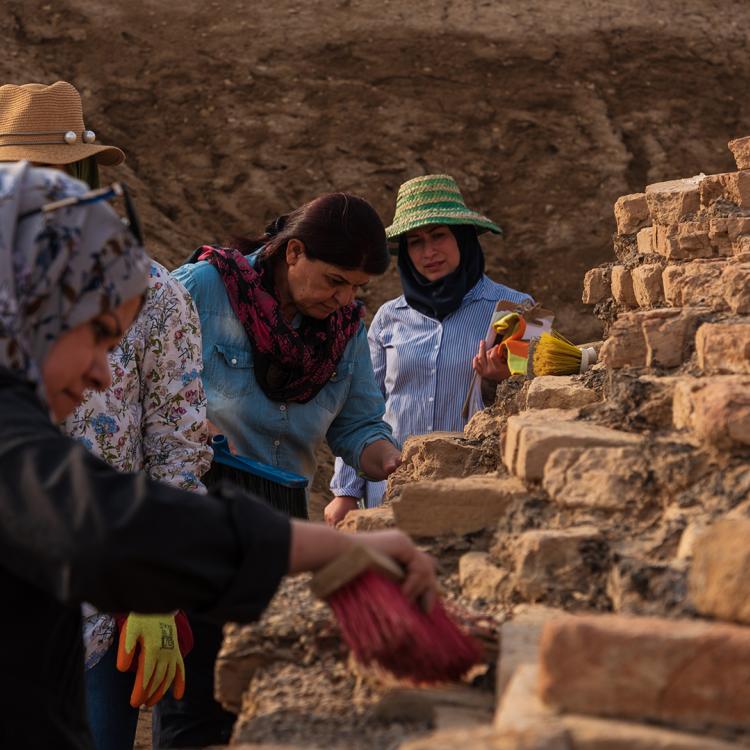Key project information
Duration
2024–2026
Contact details
Email: middleeast@britishmuseum.org
Funded by
Meditor Trust
Partners
State Board of Antiquities and Heritage
Iraq Museum, Baghdad
University of Al-Qadisiyah
The Girsu Project combines research, on-site training and heritage management of one of the world's oldest cities.
The Sumerian site of Girsu (modern day Tello, Iraq) is one of the great treasures of Iraqi heritage. Revered in the 3rd millennium BC as the sanctuary of the Sumerian heroic god Ningirsu, Girsu was a megacity covering hundreds of hectares at its peak.
Today, the site is marked by huge excavation pits and spoil heaps − the remnants of 19th- and early-20th-century lootings and excavations that lacked a methodological approach to fieldwork. Many architectural features were exposed too quickly and poorly documented, meaning the spectacular finds from the site, now in museums around the world, lack archaeological context.
The Girsu Project is responding to these urgent issues through new excavations, site conservation and complete documentation of the site using cutting-edge technology.
Find out about the latest project news.
About the project
The rediscovery of Girsu in the 19th century revealed the Sumerian civilisation to the world. However, after the Second World War and the ensuing conflicts in Iraq, there was limited focus on the site. For more than 80 years it has been left open and exposed with no conservation work to address long-term stability or issues of erosion.
This project will 'revive' Girsu by raising awareness of its importance as an archaeological site. It also marks a new beginning in the search for the origins of urban life and its significance for early state formation, the invention of writing and the development of complex societies.
So far, the project has worked alongside Iraqi colleagues to investigate the world's earliest bridge, the temple and the sanctuary of Ningirsu and the city's administrative centre in Tablet Hill. This has revealed a wealth of information on the origins of Girsu and the birth of urban centres in Mesopotamia. The project has also provided training to Iraqi archaeologists and conservators, as well as university students, and engaged with communities close to the site.
Important finds will soon be displayed in the Iraq Museum in Baghdad and outcomes will be disseminated through a wide range of publications.
Aims
The project will:
- Reinterpret the ancient city of Girsu through new fieldwork and re-examination of older discoveries.
- Provide capacity-building training to Iraqi archaeologists, conservators and university students as part of the research excavations, demonstrating innovative methods, new technologies and best practice to trainees to support current and future archaeological projects across Iraq.
- Undertake new excavations and re-excavate areas inadequately recorded before 1933. This will provide an opportunity to re-contextualise museum objects originating from these buildings and ensure proper documentation and conservation. Looting is also a major problem at the site, which the project addresses through the forensic excavation of robber holes to help establish the provenance of stolen objects from the site.
- Document all material uncovered at Girsu between 1877 and 1933, now dispersed in collections around the world, to re-contextualise collecting histories and re-evaluate objects newly excavated at the site.
- Produce comprehensive topographical and geophysical mapping, scanning and 3D modelling of the site complemented by programmes of non-invasive geoarchaeological fieldwork that reconstruct the ancient environmental setting and its hinterland.
- Result in the publication of seminal books and other contributions to the history and archaeology of Girsu and the Sumerian world.
- Prepare the site to welcome visitors with the installation of information panels and signposts, and increase digital accessibility to the site.
Meet the team

Sébastien Rey
Project Director
Department of the Middle East
British Museum

Uxue Rambla Eguílaz
Project and Cultural Heritage Manager
Department of the Middle East
British Museum

Ebru Torun
Site Conservator and Heritage Manager
Department of the Middle East
British Museum

Fatma Yassir Husain
Assistant Director
Department of the Middle East
British Museum
Meet the team continued
Supporter
Project supporter
Supported by
Meditor Trust
Outputs
Sacred space and ritual behaviour in ancient Mesopotamia: a view from Tello/Girsu
ARTICLE
Tina Jongsma-Greenfield; Angelo Di Michele; Fatima Husain; Sébastien Rey
Published in 2024
The Temple of Ningirsu: The Culture of the Sacred in Mesopotamia
BOOK
A fascinating account of the discovery and history of the Temple of Ningirsu at the site of the ancient Sumerian city of Girsu.
Sébastien Rey
Published in 2024
Dating ancient canal systems using radiocarbon dating and archaeological evidence at Tello/Girsu, southern Mesopotamia, Iraq
ARTICLE
Ella Egberts; Jaafar Jotheri; Angelo Di Michele; Antony Baxter; Sébastien Rey
Published in 2023
Thunderbird: A Temple Hymn from Ancient Sumer
BOOK
Sébastien Rey; Christine Rebet
A book that brings to life a temple hymn from ancient Mesopotamia that celebrates the power and splendour of the divine House of Ningirsu, built by the Sumerian ruler Gudea.
Published in 2020
For the Gods of Girsu: City-State Formation in Ancient Sumer
BOOK
Sébastien Rey
A book demonstrating how Girsu is a primary locale for re-analysing the origins of the Sumerian city-state through an interdisciplinary approach combining archaeological and textual evidence.
Published in 2016







